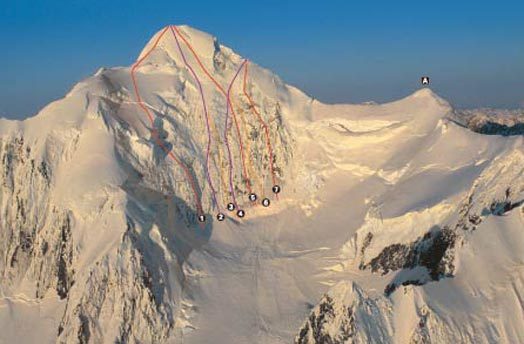
The 600-meter south face of Mt. Tasman, the second highest peak in New Zealand. Point A indicates the Silberhorn. Approximate route lines for the following are shown (commitment grades are the only grades available unless otherwise indicated): 1. Surreal Insomnia (V WI6+, 600m, Cotter-Sedon, 2003). 2. Mists of Avalon (VI, 600m, Dignan-Fantini, 1986). 3. Left Buttress (VI, 600m, Beare-Entwisle, 1983) 4. Rattus Balfourus (VI, 600m, Braddock-Logan, 1982). 5. Original Route (VI, 600m, Denz-Pooley, 1971). 6. Mr. Curly’s Big Adventure (V 5.10 70 degrees, 600m, Chapman-Stock, 1995). 7. Right Buttress (V, 600m, Sandifort-Vervonsi, 1997). Not shown between routes 6 and 77 is an unnamed route (VI-, 600m, Lindblade-Whimp, 1993). [Photo] Rob Brown
Dawn, April 10. Guy Cotter and I stood amongst avalanche debris on the Balfour Glacier beneath New Zealand’s ice climbing trophy, the Balfour Face of Mt. Tasman (3497m). This icy, six-hundred-meter south face lies in the center of the Southern Alps. The route we had eyed in the guidebook photo was once severely threatened by unstable hanging ice cliffs. Now, in late summer conditions, and with a little global warming, it looked on.
Thirty minutes later Guy won the “paper, scissors, rock” and scrambled into an ice gully that quickly steepened to vertical. Seventy meters later I screamed in pain as my frozen hands rewarmed. After the feeling of wanting to vomit passed, I headed out onto the steep ice face of the second pitch. Looking down at Guy at his hanging belay was outrageous. Already the glacier below was sinking away, and a fantastic feeling of exposure started to take hold.
Guy led past into the second crux of the route, another shield of vertical ice that looked overhanging from my position. Dinner plates shattered down next to me as he led up and out of sight.
We arrived at where we thought the angle would ease. Alas, steep ice led to overhanging bulges and vertical walls. After half a pitch the angle eased, and I scrambled up past an inactive-looking ice cliff. Three more pitches and I arrived at a tired-looking partner. The unavoidable, overhanging ice cliff above him ran across most of the face. I slumped down on the welcome, flat ground while we ate, drank and pondered the problem above in the warm afternoon sunshine. With no sleeping bags and the sun sinking closer to the Tasman Sea, Guy set off up the overhanging, twenty-meter ice cliff. Luckily a ramp led left up the cliff, but the climbing was hard and awkward. Guy half-aided and half-ice climbed the steep ramp. After breaking off the chandeliers dangling from the lip, he disappeared over the top. Following was desperate: my arms cramped, the ice was brittle, and there was no way to communicate. As I poked my head over the lip I saw Guy on flat ground with a big smile, but one that had a “don’t fall off, this anchor is shit” emphasis.
We charged for the summit, often gazing over our shoulders at the bright red sun sinking into the ocean. Sunset from the top of New Zealand’s second-highest mountain is a pretty special experience; now it was made all the sweeter by our new route, Surreal Insomnia (V WI6+, 600m).
Thankfully a couple of friends, Al Uren and Lionel Clay, had left a nice track after doing the Original Route. Darkness and snow showers surrounded us as we carefully down climbed to Engineer Col and over Mt. Lendenfeld (3194m), reaching the hut just after midnight.
— Mark Sedon, Wanaka, New Zealand